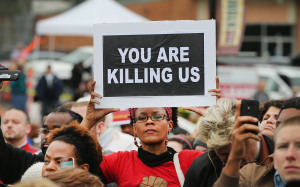Troubling Questions about Killers in America’s Streets

Why do we allow veterans of recent wars to keep their weapons at home? Sometimes I think I’m alone in noticing a troubling American social pattern. When I mention how it keeps coming up again, others admit that they too noticed it. That’s all. It’s not the sort of thing one can easily follow.
Because media ignores it, the aggravation seems to disappear. Then it returns, as it did with the latest school killings—this time at the school in San Bernardino, California, this week.
I expect mine will be a highly unpopular opinion—it’s a hard one for Americans to swallow. But it has to be pointed out that when our military teaches our men and women to kill, legally, there is a terrifying and common spillover here at home, namely: they go on killing.
I have never been privy to the way military authorities pump up soldiers to kill, to revenge their fallen comrades, to hunt what are presented as savage animals who would take away ‘our freedoms’. But I‘ve heard enough to know that military training really hardens men, subjecting them racist and violent language to motivate them on the battlefield. Soldiers also learn to feel comfortable with weapons; they become highly attached to their guns.
We have to own up to it. As much as our presidents celebrate “these gallant men and women who put themselves in harms way”, U.S. veterans are increasingly among the killers in our own neighborhoods. They are among the gun-lovers and gun owners killing us and our children– in our streets, in airports, in their homes and in our schools. When will we disarm these men who we celebrate for killing Iraqis, Afghanis, Syrians, Yemenis, Somalis?
In the case of Marine Chris Kyle of “Sniper” fame, the six dead in the baggage hall of Ft. Lauderdale airport, and this week’s San Bernardino’s North Park Elementary School killings, focus is on the victims. Yes, teacher Karen Elaine Smith deserves to be known and mourned nationally. So too, 8-year old Jonathan Martinez. That this teacher was dedicated to working with special-needs children, and the dead child himself suffered from an illness, makes the violence against them all the more despicable.
But news reports in this massacre’s aftermath, and likely in the weeks ahead will, according to common practice, fail to adequately investigate implications of the killer being a U.S. veteran who served in American wars in Iraq and Afghanistan.
In the case of the famous Iraq ‘war hero’ Chris Kyle, films and memorials celebrated this soldier’s killing power—160 kills, was it?—his victims may also have been teachers, perhaps among them, fathers, and brothers of boys like Jonathan Martinez. When Kyle was later murdered, it was by a fellow Iraq veteran. Eddie Routh was invited by Kyle and his colleague Chad Littlefield for an afternoon’s entertainment at a local shooting range. In the course of their sport, Routh shot dead both of his colleagues.
That event received wide press coverage because of the celebrity of Kyle, where again his prowess as a killer of Iraqis was applauded. Coverage included some history of Kyle’s killer with the spotlight on his mental problems.
There were others—too many. Remember Esteban Santiago-Ruiz? He is the mass murderer of 5 (with 8 injured) at the Ft. Lauderdale Airport last January. He too was a soldier, noted for receiving 10 awards during his time in the military.
Now we have Cedric Anderson, this month’s San Bernardino schoolkiller. While investigations of his background highlight violence against women, he was also held (charges were dropped) for acts involving weapons. (There’s only cursory reference to Anderson’s 8 years in the U.S. navy.
I recall reading about a man who murdered himself and his two daughters in their home– a nice home on a nice American street—about a year ago. He too, I recall, was a military veteran. News of that massacre focused on his two unfortunate girls.
Yes, we know about PTSD. We know these boys have seen their buddies killed and wounded. We know the Department of Veterans Affairs could do better. But what about these men holding on to weapons when back in civilian life? What about the way they are trained in violence and hatred?
What about gathering data countrywide on how many killers in the U.S. over the past 25 years are veterans of recent wars? And how do U.S veterans who kill and maim, once discharged, compare with others across the globe, and in earlier U.S. wars? This epidemic needs urgent attention because we have more than two million of these young men among us. END
Barbara Nimri Aziz, a New York-based anthropologist and writer, hosted RadioTahrir on Pacifica-WBAI in New York City for 24 years. Her 2007 book Swimming Up the Tigris: Real Life Encounters with Iraq is based on her 13 years covering Iraq. Aziz’ writings and radio productions can be accessed at www.RadioTahrir.org.

